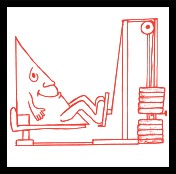Education Strategy
 Mathnasium leverages the expertise of some of the world's leading educational service executives to develop
a method of teaching that uses a unique combination of mental, verbal, visual, tactile, and written techniques
to help children learn math. It's called the Mathnasium Method™!
Mathnasium leverages the expertise of some of the world's leading educational service executives to develop
a method of teaching that uses a unique combination of mental, verbal, visual, tactile, and written techniques
to help children learn math. It's called the Mathnasium Method™!
Mental
Students are taught how and when to dispense with needless paper-and-pencil work and use mental math techniques instead. This allows them to focus on the task at hand.
Example: 99 + 99 + 99 = _____
Instead of solving this as the usual vertical addition problem, students are taught to think,
“100 + 100 + 100 - 3 = 300 - 3 = 297.” It's a different way to look at problems that can be very helpful
and productive.
Verbal
Language is an important part of the program. Students are taught the meaning of root words to help them solve problems. They are also taught how to explain their thought process and reasoning verbally.
Example: Percent
Percent is taught by breaking the word down into its components: per CENT — “for each 100.” Using this definition,
students think of “7% of 300” as “7 for the first 100, 7 for the second hundred, and 7 for the third hundred.
7 + 7 + 7 = 21.”
Visual
Meaningful pictures, charts, and tables are used to explain mathematical ideas and concepts. Many of the problems provided to students are “picture based,” giving them insights that go beyond the written words.
Example: Many of the problems in the Mathnasium program feature pictures to help in solving problems. “If each circle in the picture is a penny, how much money is shown in the picture?”
Tactile
When appropriate, the sense of touch is used to introduce, explain, and/or reinforce concepts and skills. The transfer of knowledge from manipulation to other aspects of learning is carefully monitored to ensure its effectiveness.
Examples: Counting chips is used to facilitate learning the principles of addition, subtraction, multiplication, and division. Dice and cards are used in studying probability.
Written
Written practice with computation (“drill”) is a necessary component of mathematics education. Mathnasium gives students abundant practice. In addition, our printed materials are designed to provide an orderly and understandable development of mathematical thought and skills.
Examples: Our worksheets cover the entire spectrum of math all the way from practicing “1 + 1” to dealing with three-dimensional vectors. In addition, our printed materials cover all aspects of problem solving.
Attitude and Self-Esteem
Many students come through our doors with an “I'm no good at math ... I hate math” attitude. But we know from experience that children don't really “hate math.” What they hate is being frustrated, embarrassed, and confused by math.
Being successful is the best way a student can overcome these problems. Mathnasium provides for success by finding the right starting point (through diagnostic testing) for each student and building confidence and self-esteem through successful interaction with materials carefully selected specifically for them.
Added Services
The Mathnasium Method™ also provides enrichment for students who are advanced in math, bringing them topics not usually found in the classroom. And we offer intensive remediation, if needed.
Our Approach:
For more than a decade, the Mathnasium Method™ has transformed the way children understand and appreciate math. Mathnasium's proprietary curriculum focuses on helping children build their number sense so they truly understand math.






 view
view